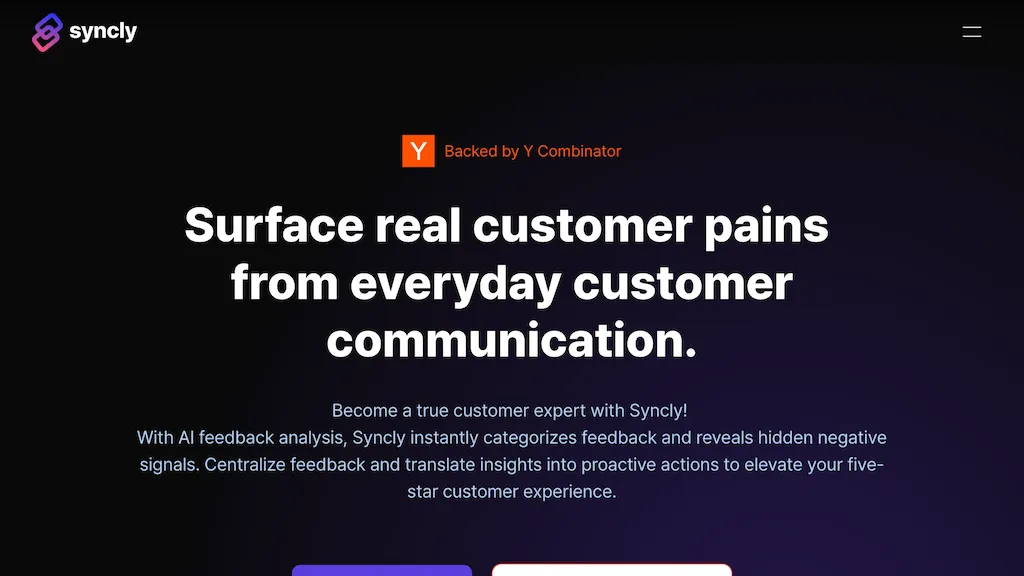What is Syncly?
Syncly is an AI-driven customer feedback analysis platform with the mission of helping businesses uncover the real pain points in their customers. By applying advanced AI techniques in feedback analysis, Syncly structures and discovers hidden negative signals across everyday communication data, enabling companies to act on what really matters and become experts in customer satisfaction.
It puts all feedback in a single location and acts proactively on the insights in real time, thereby improving the overall customer satisfaction. Development history at Syncly is founded on the need for providing an easy way for businesses to collect and manage feedback, which integrates with the existing workflow to present actionable intelligence.
Syncly’s Key Features & Benefits
Syncly contains a feature-packed suite that caters to a wide range of user needs:
-
Real-time Feedback Categorization:
Enabling the auto-tagging and categorization of customer feedback so that critical issues can be picked out at the first possible warning sign. With Dynamic Sentiment Analysis, prevent customer churn by identifying negative signals in all the various dimensions of customer interaction. -
Fluid Taxonomy:
AI-driven feedback tagging and categorization for the easy management of huge volumes. -
Auto Prioritization:
Identify and prioritize critical real-time issues and top-revenue impacting concerns to act upon, thus empowering informed decisions. -
Easy-to-use Visual Reporting:
Quickly generate visual reports for the purpose of trend and anomaly detection and easily sharing insights throughout the organization.
The features bring along meaningful benefits: higher customer satisfaction, ease of feedback management, and enhanced decision-making.
Syncly Use Cases and Applications
Syncly is versatile in its applications, serving various industries and sectors:
-
Customer Support:
Quick responses to customer issues are enabled through auto-categorization and -prioritization of feedback. -
Product Management:
It provides insights from user feedback to guide product development and improvements. -
Marketing Research:
To fine-tune marketing strategies, the tool must be able to analyze customer sentiment and feedback trends.
Syncly has been able to make customers successful for teams by making available all-in-one feedback management and analysis, ensuring that organizations are able to proactively improve their customer experience strategies.
How to Use Syncly
With a friendly user interface and the ability to be integrated seamlessly with other apps, it’s easy to use Syncly:
-
Integration:
Integrate Syncly with Intercom, Front, Zendesk, Slack, Salesforce, and Gmail via Zapier. -
Feedback Collection:
Bring all feedback from various channels into a single location. -
Analysis:
Analyze and organize feedback with dynamic sentiment analysis and fluid taxonomy in Syncly. -
Reporting:
Make visual reports for trend spotting and outliers, sharing insights, and proactive actions.
Some best practices are regularly updating the integration settings, editing taxonomy tags to suit your business, and continuously monitoring sentiment analysis reports.
How Syncly Works
Syncly interprets customer feedback data by using the most advanced AI algorithms and models in the following steps:
-
Data Collection:
This is the aggregation of feedback from multiple channels. -
Sentiment Analysis:
It detects sentiment and categorizes feedback using NLP techniques. -
Tagging and Categorization:
Applying AI-driven tags to the feedback, which makes it easy for sorting and prioritization. -
Reporting:
Enabling actionable insights and trend detection by visualizing data.
This workflow delivers real-time insights that are actionable to improve customer satisfaction and improvement of general business strategies.
Pros and Cons of Syncly
Every tool does, Syncly also has some pros along with certain possible cons associated with it:
Pros:
- Real-time feedback analysis and categorization
- Seamless integration with popular tools
- Dynamic sentiment analysis for proactive customer support
Cons:
- Might take some time initially to setup integrations
- Learning curve for first-time users.
Feedback from users is that although Syncly is a very powerful tool, real value from the platform can be reaped only if one gets through the initial setup and learning curve.
Conclusion about Syncly
Accordingly, Syncly is a strong, AI-driven, fully featured real-time feedback analysis and categorization platform. Besides seamless integration and dynamic sentiment analysis, it comes with easy reporting tools, so these features make this solution very beneficial for increasing customer satisfaction and speeding up feedback management in business.
Though probably there is a learning curve, the benefits brought by Syncly surely outweigh the probable drawbacks. Further updates and developments will definitely make this platform one of the strongest solutions for businesses in different spheres.
Syncly FAQs
Q: How does Syncly integrate with other tools?
A: Syncly integrates seamlessly with tools like Intercom, Front, Zendesk, Slack, Salesforce, and Gmail via Zapier for the purpose of centralized feedback management.
Q: What industries can benefit from Syncly?
A: Syncly is versatile and will help customer support, product management, and marketing research.
Q: Is there a steep learning curve to using Syncly?
A: While there’s an initial slight learning curve with Syncly, due to its user-friendly interface and well-written documentation, users get up to speed in record time.
Q: What are the core advantages of using Syncly?
A: Among them, the principal ones are real-time feedback categorization, dynamic sentiment analysis, seamless integration, and easy-to-use visual reporting.
Q: How does Syncly help in preventing customer churn?
A: Syncly’s dynamic sentiment analysis identifies negative signals during customer interactions to alert for proactive measures to avoid churning.










